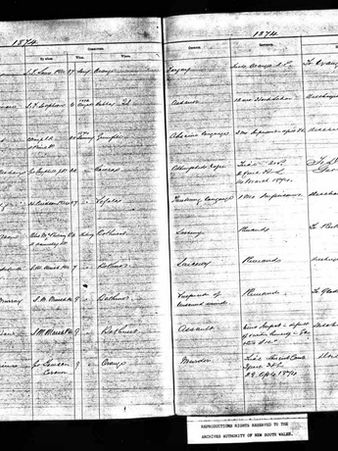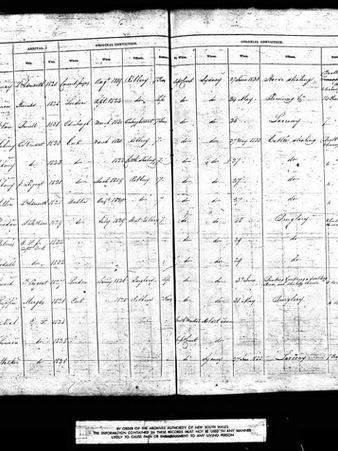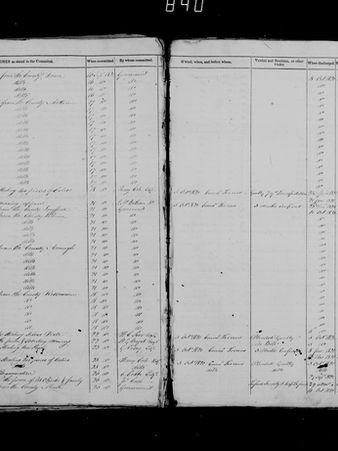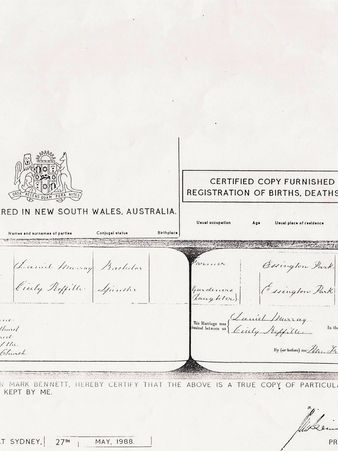top of page



The Murray family connection begins with Catherine Murray known as Kate Murray wife of John Thomas Smith and granddaughter in law of our convict John alias Richard Smith. Catherine was born at Essington Park in 1851 . Essington Park was the property of the King family. It is also where Joseph Sewell was a convict . Joseph eventually became husband of Frances Green Smith and step father to William Richard Smith, the father of John Thomas Smith. That meant Kate was also step granddaughter in law to Joseph Sewell.
The Sydney Morning Herald 3rd April 1926 gives the history of Essington Park see left.
Other history of Essington Park states:
Ref https://opus.lib.uts.edu.au/bitstream/10453/125646/7/02whole.pdf
Relationships with land of the Grantees
Before the sheep disaster of 1826, land had been granted along the Fish River, as we saw in
Chapter 3, and also along the east bank of the lower Campbells River. There were only two grants on the Oberon plateau - Captain Phillip Parker King’s Essington Park and William Davis’s Swatchfield. There is no indication that the grants on the plateau were ever more than commodities to their owners. None of the plateau’s grantees ever lived there, or built substantial homesteads, as some of the Fish River proprietors did. A few colonists who tried to acquire land on the plateau were refused by the government on the grounds that the land was not surveyed. Although there is evidence that King visited the station at least once, about 1833, it seems on that trip he was more engaged in scientific pursuits. He rode from Emu Valley on Cox’s Road over the plateau to “Mr Hassal’s house at Bolong” (Figure 5.1) south of the Abercrombie River, measuring the heights of hills. A letter to the Surveyor General, Sir Thomas Mitchell, with the results of his calculations reveals his great Enlightenment enthusiasm for this project. He spent ten days at his grant, Mobrin, (which he later named Essington Park) taking 24 barometric readings, and then visited his ticket of occupation, Paling Yards north of the Abercrombie River, but there is no record of his impressions of either. When the ‘rot’ hit in 1826, King lost almost all his 2700 sheep. His overseer William Hayes apparently reconceived Mobrin/Essington Park as primarily a cattle station. King’s widow, Harriet, retained Essington Park until her death in 1874, but the Kings never built a homestead there.
Catherine was born when Harriet King owned Essington Park. Catherine's father Hamilton Murray an Irish convict worked Essington Park. By the time she was born her father Hamilton had been issued his Certificate of Freedom which occurred on 17th January 1842, Hamilton would have stayed on as an employee on Essington Park. The 1828 census states Hamilton Murray Irish Catholic aged 28 working on the property of Captain Phillip King named Essington Park Status: Free by servitude. He had served his time. [Ref: Rockley Manners p 102]. Hamilton had an 1827 Certificate of Freedom. This certificate cites that Hamilton was accused of horse stealing in 1833 and had his freedom rescinded. He was sentenced to Norfolk Island. By 1842 Hamilton had received his absolute pardon.
1828 clip from census below. Catherine and John Thomas's story can be found under the Smiths

Looking at the story of Hamilton Murray he was baptised on 20th February 1803 in Down , County of Downpatrick Ireland to Thomas Murray and his wife Sarah. Little more is known about them. His criminal record has him born on 1st January 1801. [Ref: https://convictrecords.com.au/convicts/murray/hamilton/140359] Hamilton was convicted of stealing a cow in July of 1820 and was transported to Australia, for 7 years aboard the ship " Lord Sidmouth II. [Ref: Rockley Manners p 102]. This conviction occurred in Antrim Ireland. [https://convictrecords.com.au/convicts/murray/hamilton/140359]. His convict indents describe him as five foot seven and three quarters, having a dark freckled complexion, blue eyes and brown hair. [Ref: BDA Biog Item No. 100148344]. Lord Sidmouth left Ireland on 9th November 1820 carrying 160 convict men and arrived in Sydney Cove on 19th February 1821. Hamilton was 19 years old.
Free Settler or Felon has an excellent account of the Lord Sidmouth voyage: Ref https://freesettlerorfelon.com/convict_ship_lord_sidmouth_1821.htm
This was the second of three voyages of the Lord Sidmouth bringing convicts to New South Wales the others being in 1819 and 1823. The Lord Sidmouth was the next convict ship to leave Ireland for New South Wales after the departure of the Prince Regent in September 1820.
Surgeon Thomas C. Roylance
Thomas Roylance joined the Lord Sidmouth on 28th June 1820. [2]
Military Guard
On 15th July at Deptford Captain Richard Moore of the 45th Regiment, commander of the guard was embarked with his wife. [2]
A detachment of the 1st Royal Scots embarked as guard for the convicts, 31 in number accompanied by 13 women and ten children. The wife of Private Liddy gave birth to a child soon afterwards. On 30th August Private Faulkner was punished with 275 lashes for insubordinate conduct and disrespect to his Commanding Officer.
Cove of Cork
On the 20th they dropped down from Deptford and anchored at the 'Long Hope' below Gravesend under orders to proceed to Cork. On Saturday 22 July they anchored in the Downs and on Sunday proceeded down the Channel. They were off the Isle of Wight on 25th July and at anchor at St. Helens on 28 July 1820. They moored in the Cove of Cork on 3rd August 1820. [2]
Surgeon's Instructions
Before the arrival of the prisoners Thomas Roylance issued a similar set of instructions for the care of the convicts that he had previously on the Hadlow.
Convicts From Kilmainham Gaol
The Freeman's Journal reported on 9 October 1820 -
This morning between 3 and 4 o'clock the embarkation of convicts from Newgate and Kilmainham Jails took place. The Jailers and Sheriffs of the city and County were in attendance and got the unfortunate victims to crime doubly bolted on jaunting cars and, with a strong escort of Horse, proceeded to the Pigeon House Dock, where they were shipped on board the brig Betsey, bound for Cork. Their numbers and counties are as follows:
Co and City of Dublin from Newgate - 26
Antrim from Kilmainham - 15
Armagh from Kilmainham..7
Down from Kilmainham - 9
Kildare from Kilmainham - 2
King's Co. from Kilmainham - 13
Longford from Kilmainham - 1
Leitrim from Kilmainham - 3
Louth from Kilmainham - 12
Meath from Kilmainham 7
Roscommon from Kilmainham 10
Westmeath from Kilmainham 7 - All males.
Hamilton was embarked from Antrim from Kilmainham according to Irish Prison records. [ Ref: Find My Past Irish Prison Registers 1790-1924]
Convicts Embarked
On 7th October 1820 94 male convicts from Waterford were received on board. On 10th October another 58 men were received from Cork. On 12th October 12 more were received and four returned to shore.
Departure
They got under weigh on 9th November 1820.
Port Jackson
The Lord Sidmouth arrived in Port Jackson on Monday 19 February 1821, a voyage of 107 days. One hundred and sixty prisoners arrived under the care of Thomas C. Roylance. All were reported to be in excellent health, although Roylance wrote that from touching at no Port and some of the prisoners being debilitated and aged and from the births occurring on board it became necessary to expend the wine and medical comforts. [2]
Thomas Evans, a private belonging to the Royals, who was coming out to join the recently arrived detachments of that Regiment, by the Lord Sidmouth, drowned himself between the Heads as the vessel was entering the Harbour. The Sydney Gazette reported that he had deserted in Ireland, which prevented his being with the detachment that came by the Prince Regent, and had become entangled in pecuniary embarrassment:-those unpleasant circumstances pressed upon his mind, and are supposed to have induced him to commit the rash deed that has untimely deprived him of existence. Thomas Evans had been sentenced to 150 lashes at a Court-martial for leaving his detachment. The punishment took place on the Lord Sidmouth while the vessel was still in Cork.
Convicts Disembarked
It was reported that the prisoners brought by the Lord Sidmouth were landed at the King's Wharf on Friday 23 February in the forenoon, and after being inspected by His Excellency the Governor, were directed to be distributed according to their various employments and avocations.
The 1822 Muster identifies he was assigned to G possibly Lieutenant W? King Parramatta.
The Melville and Bathurst Population Book 1824 has Hamilton assigned to Mrs King . In the Thematic History Of Oberon http://oakycamp.com/_pdfs/History_of_Oberon_Shire_2004.pdf] this period is described as:
The first white people to live in the Oberon district were the stockmen of Sydney run-holders. Captain Philip Parker King, son of Governor King had his stock running on Bingbungel Creek (west of Oberon town) in 1823. King was a sea captain and would seldom have been there. His rural affairs were in the charge of his overseer, William Hayes. Major Druitt apparently had a run at the head of the Duckmaloi River previously when Archibald Hood asked to be located there in 1826.
King’s run was estimated in 1825 by Captain Fennell to be 7000 acres. After King formalised the purchase of 2000 acres in 1828, it was located in the Parish of Crete with Captain King’s Creek crossing one end. According to Charles Whalan’s daughter Sarah Hughes:
Captain King, son of Governor King ran stock all over what is now Oberon. He had his stockyards near where the bridge is on King’s Stockyard Creek [near the abattoir on the north eastern side of the town] – hence the name. Legend has it a stockman’s hut was near the spring near Mrs Whiteley’s house. There is a good spring there [now a dam in the common]. –the town well is down near that old flooded gum tree near the caves turn-off.
“King’s stock probably ranged over a far greater area, as when Charles Whalan jnr bought 988 acres in 1831 the land included Captain King’s stockyard, hence the name of the creek. The Essington Park house was not on King’s original Essington Park estate but on an adjoining property to the west of it. It was built by Henry Humphries in 1860.
The Mrs King cited in the 1824 census is most likely the wife of Captain Phillip Parker King and not Anna King. The 1825 muster has him employed by the Kings in Melville District ie current Oberon but states he arrived in 1816 on the Lord Sidmouth which is incorrect. The New South Wales, Australia, Colonial Secretary's Papers, 13/6/1825 Letter from William Hayes to allow Hamilton Murray and Charles Barnet per ship Prince Regent on his run 63 miles from Bathurst. Hamilton is in charge of 300 horned cattle and Charles is the hut keeper and stockman. Ref https://convictrecords.com.au/convicts/murray/hamilton/140359. The BDA states that in February 1825 in a memorial to William Hayes, Hamilton is a stockman and hutkeeper at South Creek. In September 1825 the muster shows he is in the employ of Mr King. [BDA: Biog Item No. 110634213].
As cited above the 1828 census shows he was a free stockman working on the Essington Park property having recieved his Certificate of freedom in 1827.
Hamilton appears next back in NSW from Norfolk Island [ read the document on his indiscretions] on 17th January 1842 when he receives his second Certificate of Freedom. He had been sentenced in 1833 to life / death then life but served 9 years. He returned to Essington Park where his daughter Catherine was born a mere 9 years later. Hamilton had married Celia Ruffell also known as Russell in some documents at Brisbane Valley Creek on 17th December 1857. He was a farmer of Essington Park and Celia a gardeners daughter of Essington Park. Celia was 36 and Hamilton between 54-57 years of age. Celia's death certificate cites her parents as Henry Ruffell, miner but also in 1857 the gardener in question and Mary Ann May.
It is interesting to note that Hamilton is listed as David on their marriage certificate and signs as that, whilst on Celia's death certificate her first husband is definitely Hamilton Murray. The witnesses to their marriage were linked to the Smith's- Catherine Foran and Patrick Grady.
When looking at the births of their children we can see Hamilton and Celia were a couple prior to their marriage. They married a year after their last child was born. Rockley Manners cites that this was not uncommon given Ministers visits were occasional. A 13 year occasional visit though sounds a bit far fetched!
Michael Murray 1843-1878
Edward Murray 1844-1923
John Murray 1845-1929
Daniel Murray 1848-1911
William Murray 1850 -1918
Our Catherine 1851- 1910
Mary Murray 1853-1866
Elizabeth Murray 1856-1865
We know from Smith records that children died in the period 1865- 1866 due to epidemics in the area.
We know nothing about the Ruffell's except that Celia had a brother Henry.
By 1865 we see a Hamilton Murray living in Berrima. This could be him. By 1874 Hamilton is shipped from Bathurst to Gladesville Mental Hospital. [ see picture on background of page] . The medical record below shows he died a pretty agonising death from what was Dementia or Alzheimer's Disease on 4th May 1874. This medical record lists him as being from Morwell Plains, a widower with 2 children! He would have had 6 children alive in 1874. He was certainly not a widower as Celia went on to marry William Woods in 1875 in Balranald NSW. A typo or perhaps this needs some more investigation. Celia died on 20th January 1897 at Wisemans Creek and is buried in Oberon Cemetery. Hamilton is buried in the Gladesville Asylum cemetery. That record states he died on 3rd May 1874.

bottom of page
























